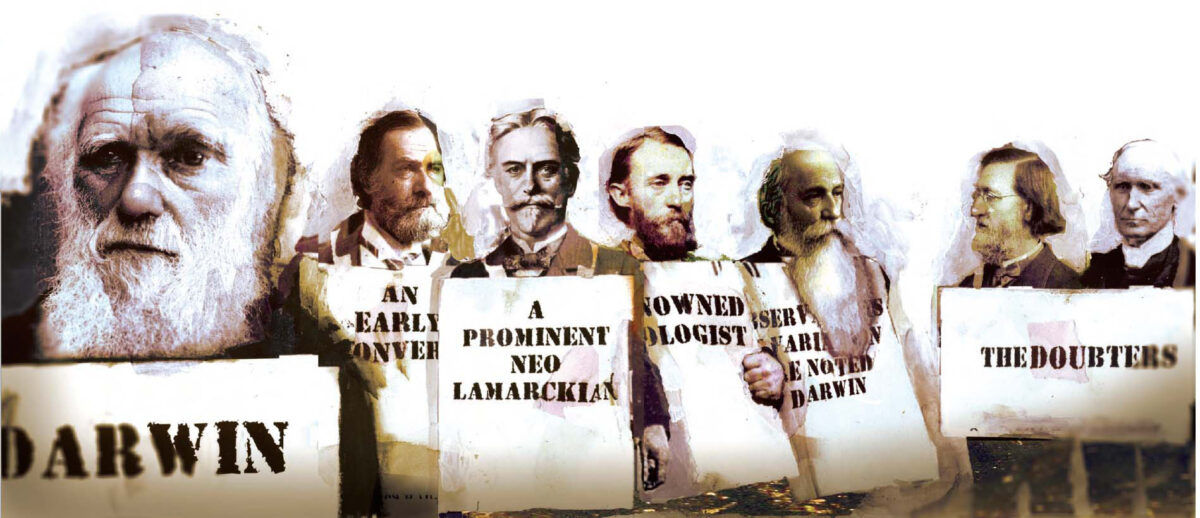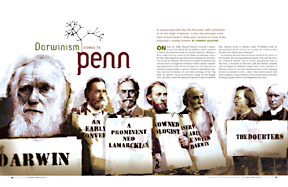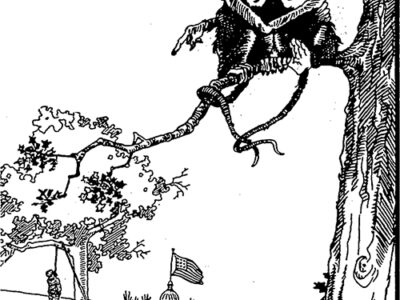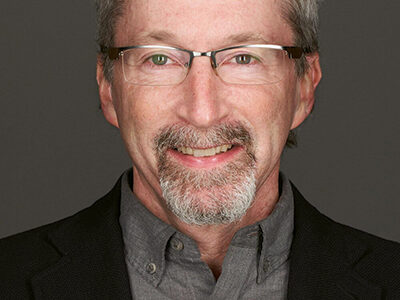
A century-and-a-half after the November 1859 publication of On the Origin of Species, a Penn microbiologist looks back at how Darwin’s ideas were received by some of the University’s leading thinkers.
By Howard Goldfine | Illustration by David Hollenbach

On June 18, 1858, Charles Darwin received a manuscript from Alfred Russel Wallace, which outlined a theory of evolution based on natural selection. Wallace’s letter came from an island in the Malay Archipelago, where he was collecting field specimens and studying the distribution of species. Wallace, like Darwin, invoked the Malthusian concept that a struggle for existence within rapidly expanding populations would be the driving force for selection of natural variants within a species. Darwin’s immediate reaction was one of dismay. He had been working on his “big book on species” since his five-year voyage on the Beagle (1831-36) and a relatively unknown naturalist had forestalled him. Darwin wrote to Charles Lyell, “If Wallace had my [manuscript] sketch written out in 1842, he could not have written out a better short abstract!”
Fortunately, Darwin had previously outlined his theory to his friends, the distinguished geologist Lyell and the botanist Joseph D. Hooker, and in a brief, unpublished draft to Asa Gray, a botanist at Harvard. Lyell and Hooker immediately arranged for Wallace’s paper and a brief summary of Darwin’s theory to be read simultaneously at the Linnaean Society in London on July 1, 1858. These were received with little comment. The president of the society later noted that nothing of great interest had happened that year.
On November 24, 1859, under great pressure, Darwin published the fuller version of his theory, On the Origin of Species, which he described as an abstract of his big book, proposing to provide more complete evidence later. The book was addressed to the literate, general public, which in the mid-19th century consisted of a small proportion of Britons. The first printing of 1,250 sold out on the first day of sale, and subsequent printings were eagerly received. Although there was considerable controversy, the earliest criticisms were mainly published in learned and religious journals. It was a book that was more discussed than read. The first American edition was published the following year by Appleton of New York. Philadelphia, one of the centers of learning, was one of the first cities on the continent to engage in the controversy. The University of Pennsylvania, the Academy of Natural Sciences (ANSP), and the American Philosophical Society were well-established institutions in the then expanding city. The reception of Darwin’s ideas was decidedly mixed.
Joseph Leidy (1823-91)
An early convert.
One of the earliest American readers of Darwin’s theory was Joseph Leidy, son of a Philadelphia hatter, who had received his medical training at Penn (1840–44), but later left the practice of medicine for a life of teaching and research. His researches ranged over much of 19th-century biology, a large part of it based on observations made with his beloved microscope—a present from his stepmother. He is acknowledged as America’s first parasitologist, having discovered the larvae of Trichina spiralis in ham. He later observed that “trichinosis, caused by trichina, [is] introduced into our body in pork, a meat which was declared to be unfit for food, thousands of years ago, by the great law-giver Moses.”
As a result of his studies, preventive medicine, which he extolled to the University’s 1886 graduating class, dictated the thorough cooking of pork and most foods. Leidy also observed bacteria related to the organisms that cause anthrax in the guts of termites. Leidy’s reputation was secured at an early age; by 1848 he was being received by eminent men of science on trips to Europe.
Leidy’s growing renown was not based on his microscopic observations alone. Numerous fossils excavated by enthusiasts and professionals were sent to the ANSP and entrusted to him. It was Leidy who showed that the modern horse had antecedents on this continent, but these had become extinct and were replaced much later by horses brought over by early European explorers. He found that, although many of the fossils he examined resembled previously discovered species of the Old World, they were significantly different and had to be carefully described, classified, and named.
Two of the era’s major fossil hunters, Edward Drinker Cope and Ferdinand Vandeveer Hayden (on whom more below), were based in Philadelphia. Leidy was the man they trusted to do the difficult work of analysis of their new finds. In view of Leidy’s wide-ranging studies, his biographer Leonard Warren, professor emeritus of cell and developmental biology at Penn and Institute Professor Emeritus at Wistar, subtitled his 1998 book on Leidy, “The last man who knew everything.”
By 1860 Leidy was professor of anatomy in the School of Medicine. His belief in the evolution of higher organisms from the simplest unicellular organisms predated his first contact with Darwin’s theory, but Origin of Species transformed his understanding. His letter to Darwin after reading the book has been lost, but Warren reports that he is said to have thanked Darwin for “putting night into day … I felt as though I had groped about in darkness, and that all of a sudden, a meteor flashed upon the skies.” Darwin responded, “Your note has pleased me more than you could readily believe: for I have during a long time, heard all good judges speak of your paleontological labors in terms of the highest respect. Most Paleontologists (with some few good exceptions) entirely despise my work; consequently approbation from you has gratified me much.” Leidy proposed Darwin for membership in the ANSP, and he was elected in 1860—an honor that Darwin gratefully acknowledged.
Leidy was not a theorist, but his immediate grasp of Darwin’s theory shows him to be a man who understood and could appreciate Darwin’s ideas. This was in large part because his observations of microscopic organisms, insects, mollusks, and the large ancient fauna bore evidence that entirely supported them. In his address to the medical school Class of 1886, Leidy noted that “The genesis or original production of life is directly attributed to God, but the manner of its creation has always been and still remains a mystery … According to the doctrine of the evolution of life, living beings have derived from one another, the most complex and highest forms of plants and animals being the slowly modified descendants of less complex plants and animals … and so on until we go back to the earliest and simplest plants and animals.” Leidy believed that the formation of the infinite number of kinds of living things can be explained by the “incessant individual variation … their adaptation ‘to environing conditions’ and transmission of acquired individual peculiarities.”
Whether he meant acquired in the sense of Lamarckian adaptation or through variation in the hereditary makeup is not clear from this statement, but many naturalists at the time leaned towards the view that changes in living organisms resulted from adaptation to the environment and somehow these newly acquired characteristics were passed on to their progeny. For a time at the end of the 19th century neo-Lamarckism had become the dominant theory of evolution.
In the same lecture, Leidy said that Darwin’s theory met many objections at first, just as Newton did when he “announced the law of gravitation, people objected to it, for they regarded it as a denial of God’s control of the movements of the universe; and when Franklin suggested the use of the lightning-rod, it was denounced as an impious attempt to deprive the Deity of his thunderbolts.”
Leidy was highly honored during his life with election to over 50 national and international scientific societies and prestigious lectureships, but his reputation did not last far into the following century. His modesty and unwillingness to theorize have relegated him to the second rank of naturalists even though he was one of the greatest American scientists of his day. Recently, debate over Leidy’s historical significance has begun to revise our estimation of his importance for 19th-century American science.
Edward Drinker Cope (1840-97)
A prominent neo-Lamarckian.
A very different character was the opinionated, effervescent Edward Drinker Cope. The Copes belonged to a prominent Philadelphia family that had made its fortune in shipping. Edward was a precocious child; reading, writing, and expressing himself in long sentences by the age of six. At first he was homeschooled, but later attended a Quaker day school from age nine. Most of his formal education was at the old Friend’s Select School (now Westtown School) in Chester County.
After leaving school at 16 he worked on farms during summers and continued his studies in biology at home in addition to studying French and German so that he could read the scientific literature. He studied briefly at Penn in his twenties, attending Leidy’s course on comparative anatomy. Based on his early work at the ANSP and at the Smithsonian Institution in Washington, he was appointed professor of zoology at Haverford College in 1864. With his annual salary of $1,000 he was able to marry Annie Pim, but he resigned his professorship in 1867 and moved to Haddonfield, New Jersey, in order to be close to the recently discovered fossil beds there.
Greater fame came to him as a result of the fossils he collected in the newly opened territories in the 1870s. In 1873 he explored the “Fish Cut” at Green River, Wyoming, made when the Union Pacific tracks were being laid. This cut revealed thick beds of fossil fish, and Cope quickly became a leading specialist. Cope and Othniel Charles Marsh, a paleontologist at the Peabody Museum of Natural History at Yale, were friendly at first, but rivalry in fossil hunting in the West led to intense mutual dislike and distrust which was widely reported and soon dubbed the “Bone Wars.” Since both Marsh and Cope were colorful characters who did not hesitate to criticize each other openly, their antagonism was prime fodder for an avid press.
Cope purchased the American Naturalist in 1877, giving him complete freedom, unfettered by peer review, to publish his voluminous output of scientific publications. In the context of gentlemanly Philadelphia society, Cope’s arrogant demeanor made him very unpopular—especially at the ANSP, a hotbed of gossip where members criticized him openly. This backbiting seemed to serve as a source of amusement to him. Despite his unpopularity, Cope became professor of geology and mineralogy (1889) and of zoology and comparative anatomy (1896) at Penn.
He, too, was an early reader of Darwin and an early adherent. A cutting from The Evening Post preserved in Darwin’s scrapbook contains a report on the American Association for the Advancement of Science meeting of 1870. It notes that “First and foremost we miss Agassiz with his piquant and sometime petulant obstinacy … Last year at Salem, Cope of Philadelphia, reverentially but thoroughly floored him in debate.” Louis Agassiz, professor of zoology and geology at Harvard, was the foremost opponent of Darwin’s theory in America.
As for Cope, although he was convinced that living things had evolved, he did not accept natural selection as the driving force in evolution. Instead, he became one of the leading exponents of Neo-Lamarckism, the inheritance of acquired characteristics. In his view, natural selection would serve to fix those characteristics that made the organism more fit within its environment. He wrote that the need for changes in an organism would lead to an acceleration or retardation of growth during embryonic development of the organ affected. The same idea was proposed by Alpheus Hyatt of Boston, with whom Darwin corresponded extensively. Darwin found their writings to be unintelligible, and eventually gave up trying. In expounding his views, Cope invented new terms such as bathmism (growth-force), kinetogenesis (direct effect of use and disuse and environmental influences), and others, which tended to confuse his readers.
Although he had inherited a significant fortune, Cope’s expeditions eventually exhausted his funds and he was forced to sell fossils from his collection and rent out his primary residence on Pine Street. His over-exertions and self-medication resulted in rapidly declining health and death at a relatively early age, but his memory is retained in Philadelphia through commemorative markers and more widely in species named after him. Urns containing his and Leidy’s ashes rest near each other at the Wistar Institute.
Ferdinand Vandeveer Hayden (1829-87)
Renowned geologist.
In addition to the Leidy Laboratories, Penn’s other campus building named for a 19th-century scientist is Hayden Hall, home of the Department of Earth and Environmental Science. Ferdinand Vandeveer Hayden served as professor of geology at Penn from 1865 to 1872, but the great part of his career was spent as a government geologist surveying the territories of Nebraska, Dakota, Montana, and Wyoming, and later with the newly formed U.S. Geological Survey. His first journey up the Missouri River by steamboat was in 1853. On his second expedition the following year Native Americans he met named him “the-man-who-picks-up-stones-running,” because when they chased him down they found only his pick, hammer, and fossil bones and shells—nothing of value in their eyes. But these fossils and the surveys he carried out were the things of lasting value for which he is remembered.
Hayden was born in Westfield, Massachusetts. He attended Oberlin College, where he concentrated on literary studies but maintained a strong interest in the natural sciences. His geology instructor George Allen taught that all creation was fixed and stable, clearly illustrating the Creator’s work. He went on to study medicine at Albany Medical College, where he met James Hall, a well-known geologist. Before completing his medical studies he wrote to Spencer F. Baird, the influential assistant secretary of the Smithsonian Institution: “I am extremely anxious to spend a few years in the study of natural history. I feel as though I could endure cheerfully any amount of toil, hardship and self-denial provided I could gratify my strong desire to labor in the field as a naturalist.”
This professed interest and Hayden’s collecting skills convinced Baird that he “was made of the right material for ultimate success.” Thus on his trip to explore the upper Missouri River, Baird supplied collecting materials and a long list of specimens he desired for the growing Smithsonian collections. But Hayden did not stop at living species; he also collected fossils that were sent to the Academy of Natural Sciences in St. Louis and the ANSP in Philadelphia. Leidy was the main recipient of his fossils in Philadelphia, but soon Hayden found himself caught between the competing demands of Cope and Marsh for new specimens.
The Civil War interrupted Hayden’s work in the field. He enlisted in the Union army in 1862, eventually becoming chief medical officer of the Army of the Shenandoah. In 1865 he was appointed professor of geology at Penn, a position he held until 1872, when his ever-increasing survey duties in the West came into conflict with those at Penn. (Examination of minutes revealed that he rarely attended faculty meetings.)
Hayden published extensively, including official reports on the surveys he had led. These publications covered fields as diverse as geology, geography, mineralogy, agriculture, ethnology, archaeology, and both living and fossil fauna and flora.
Hayden has been variously characterized as a loner and a maverick, impulsive and quarrelsome. In this respect he differed from Leidy who shunned controversy. Hayden understood that his fossil and geological findings supported Darwin’s theories, but usually avoided discussion of the theoretical implications of his work. Comparing fossil leaves of the Cretaceous Period with living flora he wrote, “The inference is, therefore, that this flora illustrates the great law of progress: commencing with great simplicity of form and advancing, step by step to greater complexity and beauty.” His biographer Mike Foster observes that unlike many naturalists at the time, Hayden never came out against Darwin, indicating tacit acceptance.
The later stages of his career led to disappointment. He garnered strong support in Congress to be appointed head of the newly formed U.S. Geological Survey, but in 1879 the post went to his rival Clarence Rivers King. As a sop, Hayden was appointed U.S. Geologist, but he received no assignment from King. His health declining, he moved back to Philadelphia with his wife, Emma, and did not return to the field until 1883 when he explored Montana with A. C. Peale, but ill health forced him back after a month. His last expedition with Peale resulted in the discovery of coal beds between the Gallatin and Madison rivers. He lobbied for and was successful in the designation of the Yellowstone region as a national park, the first.
On his death in 1887 his colleague J. P. Lesley wrote “his name was more familiar in the geological world in Europe than any other American geologist.” Cope said, “He is the founder of our knowledge of geographical geology of North America from the easternmost border of the plains to the Wasatch Mountains.” His worldwide fame resulted in his election to 91 honorary societies.
Samuel Stehman Haldeman (1812-80)
Whose observations on variation were noted by Darwin
From the banks of the Susquehanna River came evidence of variation within species among fresh water mollusks. S. S. Haldeman, another wide-ranging scholar, was appointed professor of the natural sciences at Penn in 1852. After taking the same chair at the University of Delaware he returned to Penn as the first professor of comparative philology in 1869 and held that position until his death. He had attended Dickinson College in Carlisle, Pennsylvania, where he came under the influence of the geologist Henry D. Rogers, but did not complete his undergraduate studies. Like Cope he studied at Penn and attended discussions at the ANSP and the American Philosophical Society. He moved back and forth between Philadelphia and his family estate, sawmill, and iron foundry on the Susquehanna River, about 20 miles below Harrisburg.
A keen observer of his natural surroundings, the young Haldeman became a collector of fresh water shells and learned taxidermy on the small animals he trapped and shot. These collections and studies eventually led to his Monograph of the Fresh-water Univalve Mollusca of the United States (1842). Haldeman also published on long-horned beetles, edited several volumes on insects, and was one of the founders of the Entomological Society of Pennsylvania, the first of its kind in America.
Haldeman had an acute sense of hearing; this and his failing eyesight led him to turn to the study of both human and animal sounds. He studied the languages of Native Americans and began to publish in ethnology by the end of the 1840s. He travelled to Europe six times in order to study the languages of the countries he visited, and also those of the polyglot communities of the major cities. He wrote on reforming English spelling based on phonetics and championed the removal of silent letters in words like labour and colour. He was one of the founders of the American Philological Association and served as president, 1876-77.
In the introduction to Origin of Species, Darwin notes that, “In 1843-44 Professor Haldeman … has ably given the arguments for and against the hypothesis of the development and modification of species: he seems to lean towards the side of change.” Lyell and Hooker, who were reading Darwin’s text before publication, reminded him of Haldeman’s paper in the Boston Journal of Natural History. In letters dated June 21 and July 2, 1859 Darwin wrote them that he had read and abstracted Haldeman’s paper, and remembered thinking it “very clever,” but not of much use to him. “[I]t did not seem to me to give any idea, like natural selection … The speculations approach mine & Wallace’s, but did not on any point seem to me identical.” Indeed, Haldeman touched on adaptation to new environments leading to new species, but did not develop the concept of natural selection. Most of his article concerns arguments for or against the Lamarckian hypothesis, but he refused to come down on one side or the other.
Daniel R. Goodwin (1811-90) and J. Peter Lesley (1819-1903)
The doubters.
The Rev. Dr. Daniel R. Goodwin was provost at Penn from 1860 to 1868. He arrived at a time when the College was beginning to regain the reputation it had had during its early days and is credited with elevating the tone of the institution and reestablishing college discipline. However his reign was cut short. In addition to his duties as provost, Goodwin held a chair at the Philadelphia Divinity School, an Episcopal institution not connected to the University. He was eventually forced to resign as provost in order to continue his work there.
Goodwin wrote, “The Lamarckian or developmental theory … professed to retain, while in fact it dispensed with, the idea of God as a Creator. But this theory of Mr. Darwin openly dispenses with law itself … [it] throws itself without reserve upon the illimitable ocean of accident.” Of the principle of natural selection, he thought it was only another name; it suggested no real cause.
It is not surprising to hear this sentiment from a theologian in 1860. Yet, by the latter part of the 19th century most theologians had reconciled themselves to biological evolution, but many believed it was divinely guided, arguments that continue to this day.
J. Peter Lesley was professor of geology and mining at Penn (1859-1883) and the first dean of the Towne School of Science. Although he had trained for the ministry and had practiced for a time in the Boston area, his concurrent work on the geological survey of Pennsylvania’s coal regions resulted in an eminent scientific career. In 1859 he was appointed secretary and librarian of the American Philosophical Society, and in 1874 he was appointed director of the Second Geological Survey of Pennsylvania, in which he led 80 assistants who prepared numerous reports of importance to the growing coal and oil industries. Lesley traveled to Europe numerous times and met many of the eminent men of science, including Darwin and Lyell.
His book, Man’s Origin and Destiny (1868), and his letters, edited by his daughter Mary Lesley Ames, reveal a lively mind thoughtfully considering Darwin’s theory. At first he was inclined towards it. He wrote that he saw “the oldest fossil in the world; and lo, it is a rhizopod, a creature belonging to the very lowest forms of life … But when we see these lowest of all known forms standing alone at the very beginning of time and man, the highest and noblest form, appearing at the end … what open mind can help imbibing, if not the Darwinian doctrine, at least the spirit of the Theory of Development.” (In the 19th century Darwin and others wrote of development, which was replaced by the word evolution.)
But by 1880, Lesley, who was a deeply religious Unitarian, had emphatically turned against it. In a letter written from Antwerp on July 8, he discusses the theory as elaborated by Ernst Haeckel, the eminent German naturalist who endorsed and popularized Darwin’s work in Germany. “I join Dr. Elam and John Le Conte, and a thousand other men of science in their secret soul will join him with me, in asking: Is this Science? Has Huxley gone mad, to indorse such rubbish, shot upon the stage of human intelligence by the wild dreamer of Germany …”
Elam’s article had attacked Haeckel for his materialism and especially for inventing new taxa to fill in breaks in the fossil record. The next day Lesley wrote, “I have finished Elam’s article:—he goes too far,—he gets angry and excited. The juste milieu is always above our human capacities. But I am thankful for so earnest a protest against the prevalent epidemic scientific superstition of the day.”
The problems that beset Lesley, a thoughtful man, and others continue into the 21st century. Creationism has given way to Intelligent Design; textbook writers are exhorted by school boards and legislatures to “teach the controversy.” Indeed there are issues that science has yet to resolve and much, thankfully, remains to be discovered.
But Darwin’s theory is the cornerstone of modern biology. The evidence for evolution is overwhelming; the missing links have been and continue to be found; hundreds of genomes of all forms of life have been sequenced, revealing their common origins; and the Earth is old—very, very old—as Darwin predicted, even in the face of his scientific critics. Darwin did not understand heredity, but we now know how it works. The genes provide an indelible record of the long evolution of life on earth.
Howard Goldfine is a professor of microbiology in the School of Medicine and co-chaired Penn’s Year of Evolution in 2008-09.




